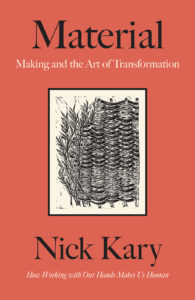SDA Book Club: “Material” reviewed by Faith Hagenhofer
August 6, 2021
This month’s addition to the SDA Book Club is “Material: Making and the Art of Transformation” by Faith Hagenhofer.

“Material: Making and the Art of Transformation” by Nick Kary, reviewed by Faith Hagenhofer
This very British interrogation of resources, the raw materials for a maker’s hand is tragedy driven. Whether its purpose from the start was for Nick Kary to expunge the trauma of a fire that destroyed his wood-working shop is not clear, but it seems to have done that work for the author. Kary visits and speaks with numerous craftspersons throughout southern England in a range of trips and weathers, in this work of nature and road-trip writing. His descriptions of the places he arrives at reminded me a bit of Annie Dillard’s early writings. This may sound a little rambling, and it is; in all the best ways Kary has given us an organized catalog of his seeking.
Kary sets out to delve into the resources at the foundation of his most familiar crafts, those that utilize wood, metals and clay. He carries some guilt about human resource extraction practices and uses, but it is all explored within the geographic limitations of the island that is England, and so there is no discussion of resource extraction as the basis of Britain’s empire building. Kary favors the makers, whose products and practices situate off the beaten track, closer to semi-abandoned and gone-wild spaces. He is attracted to the edges. It is also important to note that, except for a bit on basketry, which, for him, is the transformation of willow, Kary does not consider fibers in his investigations of material. This makes sense for a book that draws on a place that has been defined by lengthy and well documented historical relationships with wool, shepherding and sheep.
He knows wood best, and can therefore ask such lofty questions as “whether the quality of the plank is worth the life of the tree”. Of course the plank will also go on to become shelter or furnishing, furthering the question of its worth relative to the tree’s life. I like that he asks us to consider equations such as this one. It makes the book deliciously resonant to makers using any materials.
His intentions are squarely in (which perhaps puts them at) the center of the book: “I wish to bring the stories of our connection to nature to the fore, to make conscious our use of its resources so that our endeavours to transform materials can be beneficial to all.” (p.100)
Eventually, as he comes round to conclusions, Kary notes that we, humans of the 21st century, are losing our grip. (p.177) And he means it both metaphorically and physiologically; our hands tap and scroll more than they grasp and twist. He takes us into his own reconsiderations of intention here, noticing a responsibility to survival of trades over their extinction, in which one can detect “a proper and honest relationship between material provenance and usage” (p.188). Inevitably this leads to musings on both the craft of writing and the transformation of self that is perhaps always at the center of making, and this book.
Nick Kary and his wife Dolly run art and furniture making workshops from their creative centre,“The Brake”, near South Devon on the English coast, www.thebrake.net
–Faith Hagenhofer, is a fiber artist, shepherd, retired librarian, and has been involved with Surface Design Association for more than a dozen years. She serves as the South Puget Sound (Washington, US) SDA contact.
- Publisher: Chelsea Green Publishing (buy it here)
- Date: September 2020
- ISBN: 9781603589321
If you’ve read this book, leave a comment and let us know what you think!
Do you have a recommendation for a recent fiber-related book you think should be included in SDA’s Book Club? Email SDA’s Managing Editor, Lauren Sinner, to let her know!
